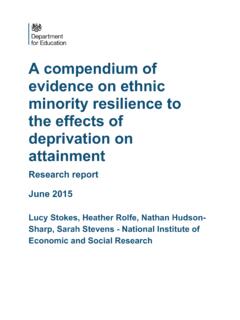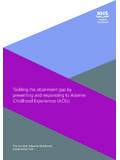Transcription of Supporting the attainment of disadvantaged pupils ...
1 Supporting the attainment of disadvantaged pupils : articulating success and good practice Research report November 2015 Shona Macleod, Caroline Sharp, Daniele Bernardinelli - National Foundation for Educational Research Amy Skipp - Ask Research Steve Higgins - Durham University Contents List of figures 4 List of tables 6 Executive Summary 8 1 Introduction 15 Policy context 15 Trends in the attainment gap over time 17 Schools priorities in spending the pupil premium 20 Research aims and methods 24 Report structure 25 2 Characteristics of schools related to the attainment of disadvantaged pupils 27 Summary 27 Introduction 28 Primary school characteristics and disadvantaged pupils performance 32 Secondary school characteristics and disadvantaged pupils performance 38 What has this study revealed about school characteristics and disadvantaged pupils outcomes?
2 45 3 Strategies used by schools to raise the attainment of disadvantaged pupils 47 Summary of survey findings 47 Introduction: overview of the headteacher survey 48 Strategies used by schools to raise the attainment of disadvantaged pupils 49 Strategies adopted by more and less successful schools 58 4 How are schools raising the attainment of disadvantaged pupils ? 70 Summary 70 Introduction: overview of school interviews 71 Implementing the same strategies differently 71 2 Barriers and challenges faced by less successful schools 82 5 Conclusions and recommendations 87 How are school characteristics related to the performance of disadvantaged pupils ? 87 What strategies are schools using and how does this relate to success? 89 What lessons can be learned from how schools implement their strategies? 89 Discussion 92 Conclusion 93 6 References 95 Appendix A: Methods and analysis 100 Appendix B: Survey data tables 110 Appendix C.
3 Results of regression modelling and factor analysis 122 3 List of figures Figure 1 Percentage of pupils achieving level 4 or above in reading, writing and maths at Key Stage 2 17 Figure 2 Percentage of pupils achieving 5 A*- C grades including maths and English at Key Stage 4 18 Figure 3 pupils mean capped points score at Key Stage 4 19 Figure 4 Study design 24 Figure 5 Illustration of the relationship between more and less successful schools 31 Figure 6 Characteristics associated with success for disadvantaged primary pupils at Key Stage 2 33 Figure 7 Characteristics associated with progress in disadvantaged primary pupils attainment at Key Stage 2 between 2012 and 2014 36 Figure 8 Characteristics associated with success for disadvantaged secondary pupils at Key Stage 4 (CAPS) 39 Figure 9 Characteristics associated with progress for disadvantaged secondary pupils at Key Stage 4 (CAPS)
4 Between 2011 and 2013 43 Figure 10 Most popular strategies used by all schools to raise attainment of disadvantaged pupils , by phase of education 50 Figure 11 Strategies identified as most effective in raising the attainment of disadvantaged pupils 52 Figure 12 Year in which schools introduced their most effective strategy for raising disadvantaged pupils attainment 53 Figure 13 Source of idea for most effective strategy 54 Figure 14 Method used to assess success of most effective strategy 55 Figure 15 Extent to which pupil premium funding supports most effective strategy 56 Figure 16 Support provided by different people/organisations 57 Figure 17 Differences in the strategies used by more and less successful primary schools 58 Figure 18 Differences in influences on decision-making between more and less successful primary schools 60 4 Figure 19 Differences in targeting strategies by more and less successful primary schools 61 Figure 20 Differences in methods used to
5 Assess the success of strategies between more and less successful primary schools 62 Figure 21 Differences in the strategies used by more and less successful secondary schools 63 Figure 22 Differences in targeting by more and less successful secondary schools 64 Figure 23 Groups of primary schools identified from the survey 66 Figure 24 Groups of secondary schools identified from the survey 67 Figure 25 Building blocks of success for all pupils , including those from disadvantaged backgrounds 73 Figure 26 An illustration of schools pathways to success in raising the attainment of disadvantaged pupils 91 5 List of tables Table 1 School characteristics included in the models: School variables 30 Table 2 School characteristics included in the models: Pupil cohort variables 30 Table 3 Differences in how schools were adopting the same strategies 72 Table 4 Profile of Key Stage 2 sample by school type 105 Table 5 Profile of Key Stage 2 sample by region 106 Table 6 Profile of Key Stage 2 sample by schools level of success 106 Table 7 Profile of Key Stage 4 sample by school type 106 Table 8 Profile of Key Stage 4 sample by region 107 Table 9 Profile of Key Stage 4 sample by schools level of success 107 Table 10 Profile of schools that participated in the qualitative interviews 109 Table 11 Q1A Which of the following strategies has your school used to raise the attainment of disadvantaged pupils in the last three years ( between September 2011 and September 2014)?
6 110 Table 12 Q1B Please identify the three strategies that you feel have been most effective. 112 Table 13 Q2 Year strategy introduced 113 Table 14 Q3 Where did you get the idea for this strategy? 114 Table 15 Q4 How important were each of the following in your decision to select this strategy? 115 Table 16 Q5 Strategy targeted on specific pupils ? 116 Table 17 Q6A If Yes, which groups did you target? 116 Table 18 Q6B If the strategy was targeted on specific year groups, which one(s)? 117 Table 19 Q7 How successful has the strategy been? 118 Table 20 Q8 How are you assessing the success of this strategy? 118 Table 21 Q9 To what extent funded by PPF? 119 6 Table 22 Q10 To what extent have the following people/organisations provided support for your plans to improve the performance of disadvantaged pupils ? 120 Table 23 Q11 What is your role? 121 Table 24 Model 1 KS2: Recent school-level attainment of disadvantaged pupils (2014) 122 Table 25 Model 2 KS2: Change in school-level attainment of disadvantaged pupils over a three-year period (2012-2014) 124 Table 26 Model 3 KS2: Change in school-level attainment of disadvantaged pupils over a three-year period (2012-2014) including changes in the cohort characteristics as explanatory variables 126 Table 27 Model 1 KS4 (5A*-C GCSE or equivalent qualifications including English and maths): recent school-level attainment of disadvantaged pupils (2014) 128 Table 28 Model 1 KS4 (CAPS): recent school-level attainment of disadvantaged pupils (2014) 130 Table 29 Model 2 KS4 (5A*-C or equivalent qualifications including English and maths).
7 School-level change in attainment of disadvantaged pupils over a three-year period (2011-2013) 132 Table 30 Model 2 KS4 (CAPS): change in school-level attainment of disadvantaged pupils over a three-year period (2011-2013) 134 Table 31 Model 3 (CAPS): Improvement in school-level attainment of disadvantaged pupils over a three-year period (2011-2013) using changes in cohort characteristics as explanatory variables 136 Table 32 Model 3 KS4 (5A*-C or equivalent qualifications including English and maths): change in school-level attainment of disadvantaged pupils aver a three-year period (2011-2013) using changes in cohort characteristics as explanatory variables 138 Table 33 Factor scoring and uniqueness for Key Stage 2 sample 140 Table 34 Factor scoring and uniqueness for Key Stage 4 sample 142 Table 35 Key Stage 2: Summary of Factor Analysis results (analysis of average factor scores by school characteristics and relative success) (1) 144 Table 36 Key Stage 4: Summary of Factor Analysis results 145 7 Executive Summary Introduction, aims and objectives The performance gap between pupils from more and less advantaged backgrounds in England is one of the largest among OECD countries (OECD, 2014).
8 The pupil premium was introduced by the coalition government in 2011 to increase social mobility and reduce the gap in performance between pupils from disadvantaged backgrounds and their peers. Schools receive funding for each disadvantaged pupil and can use the funding flexibly, in the best interests of eligible pupils . In November 2014, the Department for Education commissioned the National Foundation for Educational Research (NFER) to investigate the differences between schools in the performance of pupils from disadvantaged backgrounds. The study aimed to identify: 1. Whether there are any common features of schools that have narrowed the gap successfully. 2. Whether there are any possible groups/clusters of schools that have narrowed the gap, and why this is the case. 3. What are schools that have narrowed the gap doing compared to other schools?
9 What leads to them doing well? What lessons can be learnt from them? For the purpose of this study, disadvantaged pupils are identified in the national school datasets used in this analysis based on their eligibility for the pupil premium. This includes pupils eligible for free school meals at any point within the past six years (Ever 6 FSM) and pupils looked after by the local authority1. Key findings What are schools doing to improve the performance of disadvantaged pupils ? The survey found that schools had used a large number of strategies (18 per school, on average) in order to raise the attainment of disadvantaged pupils since 2011. The most popular strategies, and those that schools considered to be the most effective, focused on teaching and learning, especially: paired or small group additional teaching; improving feedback; and one-to-one tuition. These strategies are all supported by evidence of 1 This definition of disadvantaged pupils was used to define pupil premium eligibility prior to April 2014 and includes pupils looked after by the local authority for more than six months.
10 In April 2014, eligibility for the pupil premium changed to include pupils who have been in local authority care for one day or more and pupils who have left local authority care because of one of the following: adoption; a special guardianship order; a child arrangements order. 8 effectiveness in the Sutton Trust/Education Endowment Foundation (EEF) Teaching and Learning Toolkit2. Most schools ( per cent) had received support from governors for their plans to improve disadvantaged pupils performance and over half ( per cent) had received such support from local authorities. Although schools tended to be using similar strategies, more successful schools3 had introduced the strategy they identified as their most effective strategy earlier than less successful schools (before 2011 though they were still using it in 2014).














